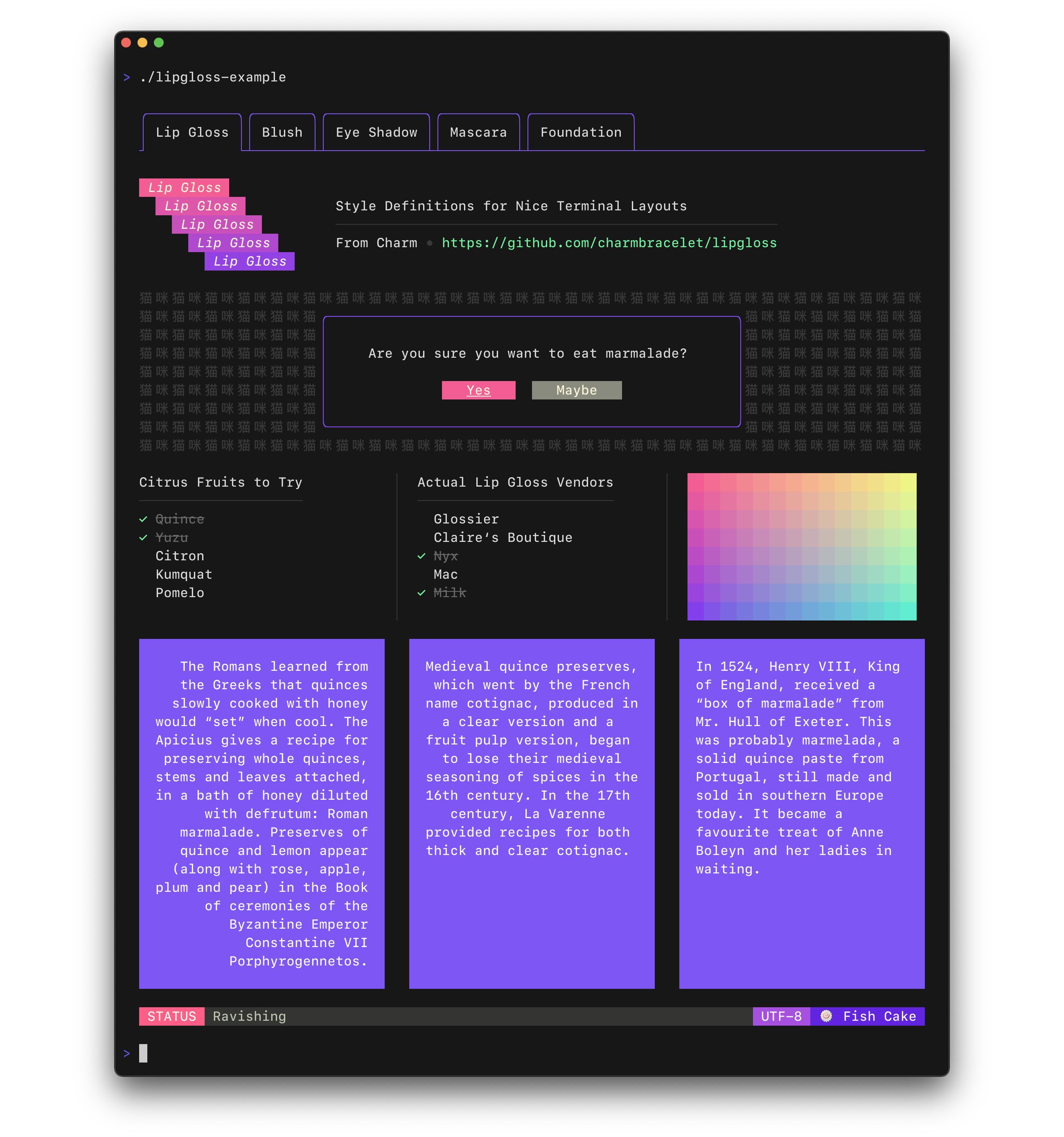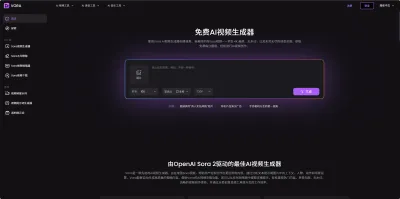Lip Gloss
<p> <a href="https://stuff.charm.sh/lipgloss/lipgloss-mascot-2k.png"><img width="340" alt="Lip Gloss title treatment" src="https://github.com/charmbracelet/lipgloss/assets/25087/147cadb1-4254-43ec-ae6b-8d6ca7b029a1"></a><br> <a href="https://github.com/charmbracelet/lipgloss/releases"><img src="https://img.shields.io/github/release/charmbracelet/lipgloss.svg" alt="Latest Release"></a> <a href="https://pkg.go.dev/github.com/charmbracelet/lipgloss?tab=doc"><img src="https://godoc.org/github.com/golang/gddo?status.svg" alt="GoDoc"></a> <a href="https://github.com/charmbracelet/lipgloss/actions"><img src="https://github.com/charmbracelet/lipgloss/workflows/build/badge.svg" alt="Build Status"></a> <a href="https://www.phorm.ai/query?projectId=a0e324b6-b706-4546-b951-6671ea60c13f"><img src="https://stuff.charm.sh/misc/phorm-badge.svg" alt="phorm.ai"></a> </p>Style definitions for nice terminal layouts. Built with TUIs in mind.

Lip Gloss takes an expressive, declarative approach to terminal rendering. Users familiar with CSS will feel at home with Lip Gloss.
import "github.com/charmbracelet/lipgloss" var style = lipgloss.NewStyle(). Bold(true). Foreground(lipgloss.Color("#FAFAFA")). Background(lipgloss.Color("#7D56F4")). PaddingTop(2). PaddingLeft(4). Width(22) fmt.Println(style.Render("Hello, kitty"))
Colors
Lip Gloss supports the following color profiles:
ANSI 16 colors (4-bit)
lipgloss.Color("5") // magenta lipgloss.Color("9") // red lipgloss.Color("12") // light blue
ANSI 256 Colors (8-bit)
lipgloss.Color("86") // aqua lipgloss.Color("201") // hot pink lipgloss.Color("202") // orange
True Color (16,777,216 colors; 24-bit)
lipgloss.Color("#0000FF") // good ol' 100% blue lipgloss.Color("#04B575") // a green lipgloss.Color("#3C3C3C") // a dark gray
...as well as a 1-bit ASCII profile, which is black and white only.
The terminal's color profile will be automatically detected, and colors outside the gamut of the current palette will be automatically coerced to their closest available value.
Adaptive Colors
You can also specify color options for light and dark backgrounds:
lipgloss.AdaptiveColor{Light: "236", Dark: "248"}
The terminal's background color will automatically be detected and the appropriate color will be chosen at runtime.
Complete Colors
CompleteColor specifies exact values for True Color, ANSI256, and ANSI color profiles.
lipgloss.CompleteColor{TrueColor: "#0000FF", ANSI256: "86", ANSI: "5"}
Automatic color degradation will not be performed in this case and it will be based on the color specified.
Complete Adaptive Colors
You can use CompleteColor with AdaptiveColor to specify the exact values for
light and dark backgrounds without automatic color degradation.
lipgloss.CompleteAdaptiveColor{ Light: CompleteColor{TrueColor: "#d7ffae", ANSI256: "193", ANSI: "11"}, Dark: CompleteColor{TrueColor: "#d75fee", ANSI256: "163", ANSI: "5"}, }
Inline Formatting
Lip Gloss supports the usual ANSI text formatting options:
var style = lipgloss.NewStyle(). Bold(true). Italic(true). Faint(true). Blink(true). Strikethrough(true). Underline(true). Reverse(true)
Block-Level Formatting
Lip Gloss also supports rules for block-level formatting:
// Padding var style = lipgloss.NewStyle(). PaddingTop(2). PaddingRight(4). PaddingBottom(2). PaddingLeft(4) // Margins var style = lipgloss.NewStyle(). MarginTop(2). MarginRight(4). MarginBottom(2). MarginLeft(4)
There is also shorthand syntax for margins and padding, which follows the same format as CSS:
// 2 cells on all sides lipgloss.NewStyle().Padding(2) // 2 cells on the top and bottom, 4 cells on the left and right lipgloss.NewStyle().Margin(2, 4) // 1 cell on the top, 4 cells on the sides, 2 cells on the bottom lipgloss.NewStyle().Padding(1, 4, 2) // Clockwise, starting from the top: 2 cells on the top, 4 on the right, 3 on // the bottom, and 1 on the left lipgloss.NewStyle().Margin(2, 4, 3, 1)
Aligning Text
You can align paragraphs of text to the left, right, or center.
var style = lipgloss.NewStyle(). Width(24). Align(lipgloss.Left). // align it left Align(lipgloss.Right). // no wait, align it right Align(lipgloss.Center) // just kidding, align it in the center
Width and Height
Setting a minimum width and height is simple and straightforward.
var style = lipgloss.NewStyle(). SetString("What’s for lunch?"). Width(24). Height(32). Foreground(lipgloss.Color("63"))
Borders
Adding borders is easy:
// Add a purple, rectangular border var style = lipgloss.NewStyle(). BorderStyle(lipgloss.NormalBorder()). BorderForeground(lipgloss.Color("63")) // Set a rounded, yellow-on-purple border to the top and left var anotherStyle = lipgloss.NewStyle(). BorderStyle(lipgloss.RoundedBorder()). BorderForeground(lipgloss.Color("228")). BorderBackground(lipgloss.Color("63")). BorderTop(true). BorderLeft(true) // Make your own border var myCuteBorder = lipgloss.Border{ Top: "._.:*:", Bottom: "._.:*:", Left: "|*", Right: "|*", TopLeft: "*", TopRight: "*", BottomLeft: "*", BottomRight: "*", }
There are also shorthand functions for defining borders, which follow a similar pattern to the margin and padding shorthand functions.
// Add a thick border to the top and bottom lipgloss.NewStyle(). Border(lipgloss.ThickBorder(), true, false) // Add a double border to the top and left sides. Rules are set clockwise // from top. lipgloss.NewStyle(). Border(lipgloss.DoubleBorder(), true, false, false, true)
For more on borders see [the docs][docs].
Copying Styles
Just use assignment:
style := lipgloss.NewStyle().Foreground(lipgloss.Color("219")) copiedStyle := style // this is a true copy wildStyle := style.Blink(true) // this is also true copy, with blink added
Since Style data structures contains only primitive types, assigning a style
to another effectively creates a new copy of the style without mutating the
original.
Inheritance
Styles can inherit rules from other styles. When inheriting, only unset rules on the receiver are inherited.
var styleA = lipgloss.NewStyle(). Foreground(lipgloss.Color("229")). Background(lipgloss.Color("63")) // Only the background color will be inherited here, because the foreground // color will have been already set: var styleB = lipgloss.NewStyle(). Foreground(lipgloss.Color("201")). Inherit(styleA)
Unsetting Rules
All rules can be unset:
var style = lipgloss.NewStyle(). Bold(true). // make it bold UnsetBold(). // jk don't make it bold Background(lipgloss.Color("227")). // yellow background UnsetBackground() // never mind
When a rule is unset, it won't be inherited or copied.
Enforcing Rules
Sometimes, such as when developing a component, you want to make sure style
definitions respect their intended purpose in the UI. This is where Inline
and MaxWidth, and MaxHeight come in:
// Force rendering onto a single line, ignoring margins, padding, and borders. someStyle.Inline(true).Render("yadda yadda") // Also limit rendering to five cells someStyle.Inline(true).MaxWidth(5).Render("yadda yadda") // Limit rendering to a 5x5 cell block someStyle.MaxWidth(5).MaxHeight(5).Render("yadda yadda")
Tabs
The tab character (\t) is rendered differently in different terminals (often
as 8 spaces, sometimes 4). Because of this inconsistency, Lip Gloss converts
tabs to 4 spaces at render time. This behavior can be changed on a per-style
basis, however:
style := lipgloss.NewStyle() // tabs will render as 4 spaces, the default style = style.TabWidth(2) // render tabs as 2 spaces style = style.TabWidth(0) // remove tabs entirely style = style.TabWidth(lipgloss.NoTabConversion) // leave tabs intact
Rendering
Generally, you just call the Render(string...) method on a lipgloss.Style:
style := lipgloss.NewStyle().Bold(true).SetString("Hello,") fmt.Println(style.Render("kitty.")) // Hello, kitty. fmt.Println(style.Render("puppy.")) // Hello, puppy.
But you could also use the Stringer interface:
var style = lipgloss.NewStyle().SetString("你好,猫咪。").Bold(true) fmt.Println(style) // 你好,猫咪。
Custom Renderers
Custom renderers allow you to render to a specific outputs. This is particularly important when you want to render to different outputs and correctly detect the color profile and dark background status for each, such as in a server-client situation.
func myLittleHandler(sess ssh.Session) { // Create a renderer for the client. renderer := lipgloss.NewRenderer(sess) // Create a new style on the renderer. style := renderer.NewStyle().Background(lipgloss.AdaptiveColor{Light: "63", Dark: "228"}) // Render. The color profile and dark background state will be correctly detected. io.WriteString(sess, style.Render("Heyyyyyyy")) }
For an example on using a custom renderer over SSH with [Wish][wish] see the [SSH example][ssh-example].
Utilities
In addition to pure styling, Lip Gloss also ships with some utilities to help assemble your layouts.
Joining Paragraphs
Horizontally and vertically joining paragraphs is a cinch.
// Horizontally join three paragraphs along their bottom edges lipgloss.JoinHorizontal(lipgloss.Bottom, paragraphA, paragraphB, paragraphC) // Vertically join two paragraphs along their center axes lipgloss.JoinVertical(lipgloss.Center, paragraphA, paragraphB) // Horizontally join three paragraphs, with the shorter ones aligning 20% // from the top of the tallest lipgloss.JoinHorizontal(0.2, paragraphA, paragraphB, paragraphC)
Measuring Width and Height
Sometimes you’ll want to know the width and height of text blocks when building your layouts.
// Render a block of text. var style = lipgloss.NewStyle(). Width(40). Padding(2) var block string = style.Render(someLongString) // Get the actual, physical dimensions of the text block. width := lipgloss.Width(block) height := lipgloss.Height(block) // Here's a shorthand function. w, h := lipgloss.Size(block)
Placing Text in Whitespace
Sometimes you’ll simply want to place a block of text in whitespace.
// Center a paragraph horizontally in a space 80 cells wide. The height of // the block returned will be as tall as the input paragraph. block := lipgloss.PlaceHorizontal(80, lipgloss.Center, fancyStyledParagraph) // Place a paragraph at the bottom of a space 30 cells tall. The width of // the text block returned will be as wide as the input paragraph. block := lipgloss.PlaceVertical(30, lipgloss.Bottom, fancyStyledParagraph) // Place a paragraph in the bottom right corner of a 30x80 cell space. block := lipgloss.Place(30, 80, lipgloss.Right, lipgloss.Bottom, fancyStyledParagraph)
You can also style the whitespace. For details, see [the docs][docs].
Rendering Tables
Lip Gloss ships with a table rendering sub-package.
import "github.com/charmbracelet/lipgloss/table"
Define some rows of data.
rows := [][]string{ {"Chinese", "您好", "你好"}, {"Japanese", "こんにちは", "やあ"}, {"Arabic", "أهلين", "أهلا"}, {"Russian", "Здравствуйте", "Привет"}, {"Spanish", "Hola", "¿Qué tal?"}, }
Use the table package to style and render the table.
t := table.New(). Border(lipgloss.NormalBorder()). BorderStyle(lipgloss.NewStyle().Foreground(lipgloss.Color("99"))). StyleFunc(func(row, col int) lipgloss.Style { switch { case row == 0: return HeaderStyle case row%2 == 0: return EvenRowStyle default: return OddRowStyle } }). Headers("LANGUAGE", "FORMAL", "INFORMAL"). Rows(rows...) // You can also add tables row-by-row t.Row("English", "You look absolutely fabulous.", "How's it going?")
Print the table.
fmt.Println(t)
For more on tables see the docs and examples.
Rendering Lists
Lip Gloss ships with a list rendering sub-package.
import "github.com/charmbracelet/lipgloss/list"
Define a new list.
l := list.New("A", "B", "C")
Print the list.
fmt.Println(l) // • A // • B // • C
Lists have the ability to nest.
l := list.New( "A", list.New("Artichoke"), "B", list.New("Baking Flour", "Bananas", "Barley", "Bean Sprouts"), "C", list.New("Cashew Apple", "Cashews", "Coconut Milk", "Curry Paste", "Currywurst"), "D", list.New("Dill", "Dragonfruit", "Dried Shrimp"), "E", list.New("Eggs"), "F", list.New("Fish Cake", "Furikake"), "J", list.New("Jicama"), "K", list.New("Kohlrabi"), "L", list.New("Leeks", "Lentils", "Licorice Root"), )
Print the list.
<p align="center"> <img width="600" alt="image" src="https://github.com/charmbracelet/lipgloss/assets/42545625/0dc9f440-0748-4151-a3b0-7dcf29dfcdb0"> </p>fmt.Println(l)
Lists can be customized via their enumeration function as well as using
lipgloss.Styles.
enumeratorStyle := lipgloss.NewStyle().Foreground(lipgloss.Color("99")).MarginRight(1) itemStyle := lipgloss.NewStyle().Foreground(lipgloss.Color("212")).MarginRight(1) l := list.New( "Glossier", "Claire’s Boutique", "Nyx", "Mac", "Milk", ). Enumerator(list.Roman). EnumeratorStyle(enumeratorStyle). ItemStyle(itemStyle)
Print the list.
<p align="center"> <img width="600" alt="List example" src="https://github.com/charmbracelet/lipgloss/assets/42545625/360494f1-57fb-4e13-bc19-0006efe01561"> </p>In addition to the predefined enumerators (Arabic, Alphabet, Roman, Bullet, Tree),
you may also define your own custom enumerator:
l := list.New("Duck", "Duck", "Duck", "Duck", "Goose", "Duck", "Duck") func
编辑推荐精选


Vora
免费创建高清无水印Sora视频
Vora是一个免费创建高清无水印Sora视频的AI工具


Refly.AI
最适合小白��的AI自动化工作流平台
无需编码,轻松生成可复用、可变现的AI自动化工作流


酷表ChatExcel
大模型驱动的Excel数据处理工具
基于大模型交互的表格处理系统,允许用户通过对话方式完成数据整理和可视化分析。系统采用机器学习算法解析用户指令,自动执行排序、公式计算和数据透视等操作,支持多种文件格式导入导出。数据处理响应速度保持在0.8秒以内,支持超过100万行数据的即时分析。


TRAE编程
AI辅助编程,代码自动修复
Trae是一种自适应的集成开发环境(IDE),通过自动化和多元协作改变开发流程。利用Trae,团队能够更快速、精确地编写和部署代码,从而提高编程效率和项目交付速度。Trae具备上下文感知和代码自动完成功能,是提升开发效率的理想工具。


AIWritePaper论文写作
AI论文写作指导平台
AIWritePaper论文写作是一站式AI论文写作辅助工具,简化了选题、文献检索至论文撰写的整个过程。通过简单设定,平台可快速生成高质量论文大纲和全文,配合图表、参考文献等一应俱全,同时提供开题报告和答辩PPT等增值服务,保障数据安全,有效提升写作效率和论文质量。


博思AIPPT
AI一键生成PPT,就用博��思AIPPT!
博思AIPPT,新一代的AI生成PPT平台,支持智能生成PPT、AI美化PPT、文本&链接生成PPT、导入Word/PDF/Markdown文档生成PPT等,内置海量精美PPT模板,涵盖商务、教育、科技等不同风格,同时针对每个页面提供多种版式,一键自适应切换,完美适配各种办公场景。


潮际好麦
AI赋能电商视觉革命,一站式智能商拍平台
潮际好麦深耕服装行业,是国内AI试衣效果最好的软件。使用先进AIGC能力为电商卖家批量提供优质的、低成本的商拍图。合作品牌有Shein、Lazada、安踏、百丽等65个国内外头部品牌,以及国内10万+淘宝、天猫、京东等主流平台的品牌商家,为卖家节省将近85%的出图成本,提升约3倍出图效率,让品牌能够快速上架。


iTerms
企业专属的AI法律顾问
iTerms是法大大集团旗下法律子品牌,基于最先进的大语言模型(LLM)、专业的法律知识库和强大的智能体架构,帮助企业扫清合规障碍,筑牢风控防线,成为您企业专属的AI法律顾问。


SimilarWeb流量提升
稳定高效的流量提升解决方案,助力品牌曝光
稳定高效的流量提升解决方案,助力品牌曝光


Sora2视频免费生成
最新版Sora2模型免费使用,一键生成无水印视频
最新版Sora2模型免费使用,一键生成无水印视频
推荐工具精选
AI云服务特惠
懂AI专属折扣关注微信公众号
最新AI工具、AI资讯
独家AI资源、AI项目落地

微信扫一扫关注公众号






